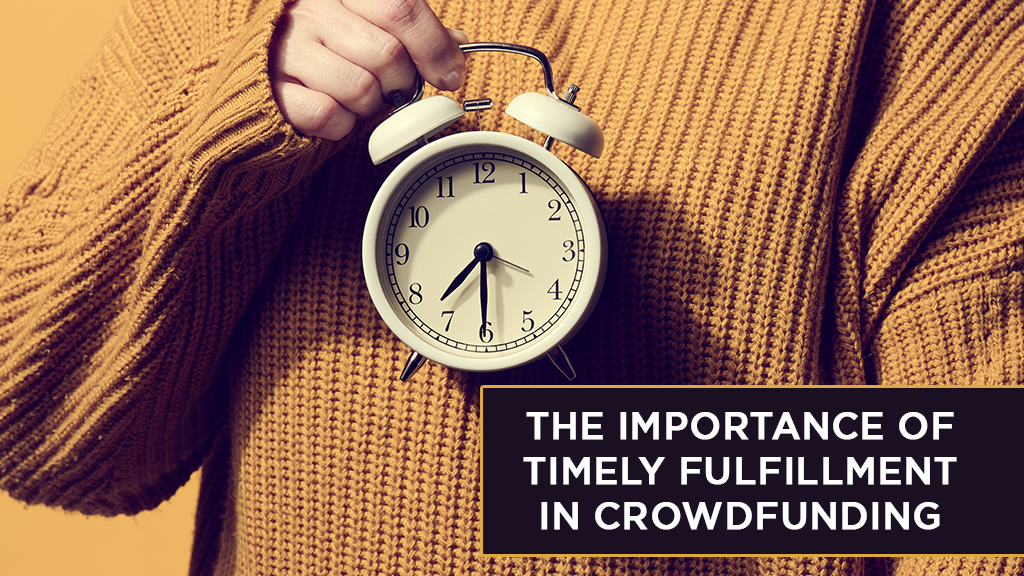
We admit, fulfillment isn’t the most glamorous part of the crowdfunding journey. It may be tempting to put it on the backburner, especially when you’re caught up in the excitement of launch.
But don’t procrastinate too long. Crowdfunding pledge fulfillment can make or break your brand.
Today, let’s talk about the importance of timely crowdfunding order fulfillment:
- Meeting crowdfunding delivery times through efficient crowdfunding logistics
- Common crowdfunding delivery challenges and how to overcome them
- Crowdfunding backer communication and gaining backer trust
- How to evaluate crowdfunding fulfillment services
Contents
- What is crowdfunding fulfillment?
- The process of crowdfunding fulfillment
- Importance of fulfilling rewards for successful campaigns
- Key challenges in crowdfunding fulfillment
- What are Kickstarter fulfillment services?
- Benefits of using Kickstarter fulfillment services
- Strategies for successful crowdfunding fulfillment
- Cost considerations in crowdfunding fulfillment
- Factors to consider when choosing a Kickstarter fulfillment service
- Selecting the right fulfillment partner
- Case studies: Successful crowdfunding fulfillment
- Best practices for crowdfunding fulfillment
- Final thoughts
What is crowdfunding fulfillment?
Here’s what Kickstarter has to say about crowdfunding fulfillment:
Fulfillment is the act of completing your project and sending rewards to backers. It usually starts at the end of a successful Kickstarter campaign, but planning begins much sooner and requires careful budgeting and solid communication. It’s also a proven way to foster trust between you and your backers for years to come.
When a backer makes a pledge, they promise to pay a specified amount at the end of your campaign. As the creator, you are making a promise right back. You commit to packaging, shipping, and delivering the product, all within an agreed-upon timeline.
Too often, we see amazing campaigns crumble to dust when product creators can’t manage crowdfunding deliverables. On the other hand, creators with successful crowdfunding fulfillment strategies gain incredibly loyal customers and put themselves on the radar for future investors and retailers.
The process of crowdfunding fulfillment
Crowdfunding shipping management is deceptively complex. It’s a multi-step process that includes:
- Setting up fulfillment goals
- Inventory management and order processing
- Packaging and shipping logistics
- Tracking and customer communication
Setting up fulfillment goals
The goal of fulfillment is to get your product to the backer’s address in perfect condition, right on time, and at the lowest cost possible.
For that to happen, you need to create a crowdfunding project timeline from production to warehousing to delivery. Create concrete goals. How long will it take you to fulfill 20 orders? 100 orders? 1,000 orders? Start outlining your game plan.

Inventory management and order processing
Inventory management is the process of tracking items as they arrive and leave the warehouse. Order processing is the act of retrieving the product from storage, packing it, and getting it to the customer.
The two are closely interdependent. Errors in inventory management will delay order processing. And incorrect order processing can cause you to overstock or understock inventory.
Packaging and shipping logistics
Once the fulfillment center packages your product, they send it to the courier, who then delivers it to the backer. Your total costs can vary drastically based on your packaging and shipping choices.
Pay attention to packaging material; your box is meant to keep your product safe, but extra bulk or weight will quickly multiply costs.
Location also impacts shipping costs. Some countries are much more difficult to ship to. And the more countries you ship to, the more regulations you have to juggle.
For example, India requires more personal documentation from the receiver. If the receiver doesn’t provide this information, your package will be returned. Brazil imposes multiple taxes and duties on imports. Countries like Iceland and the Channel Islands are considered “remote areas”, where additional fees apply.
Tracking and customer communication
Tracking numbers allow backers to check their shipping status and anticipate when rewards will arrive.
On top of that, backers want to be in the loop throughout the fulfillment process. Updates can be fun. For example, Lomi made this video when announcing its shipping timeline.
Communicate the not-so-fun aspects too. If shipments are delayed, let customers know as soon as possible. Fulfillment is all about building trust.
Importance of fulfilling rewards for successful campaigns
Fulfillment is make-or-break in your crowdfunding journey. Your success in crowdfunding fulfillment answers a critical question: Are you a one-hitshot wonder, or are you a rising star?
Many creators plan to raise investment capital post-crowdfunding. We reached out to serial crowdfunder and long-time client, Kevin Liang, to weigh in on the subject. He raised over $1.5M in crowdfunding and went on to sell an extremely successful business.
“Investors now know that a large crowdfunding campaign does not equate to post crowdfunding success. More sophisticated investors are now more interested in learning about the fulfillment, defect rate, customer loyalty, etc. from delivering the crowdfunding campaign.”

Investors are less interested in how many dollars you raised or how many backers you have. They want to know if you can deliver products on time and create excellent customer experiences. Successful fulfillment tells investors that your brand is here to stay.
Key challenges in crowdfunding fulfillment
One of the biggest mistakes first-time crowdfunders make is not thinking through their packaging and delivery strategy. Don’t let your campaign turn into a crowdfunding nightmare. Here are some common fulfillment challenges to look out for:
- Scalability and volume management
- Timely delivery and customer satisfaction
- International shipping and customs
- Dealing with unforeseen challenges
Scalability and volume management
Let’s say your campaign goes way past your funding goal. It’s a good problem to have, until you’re drowning in unprocessed orders and falling behind on shipments.
Don’t set yourself up for failure. We recommend creating simple reward tiers. For example, if one tier reward is a t-shirt, offer one or two color options instead of five.
Simpler reward tiers mean easier production, faster fulfillment, and lower costs. And if order volume spikes way up, you’ll still have the bandwidth to meet crowdfunding deadlines.
Timely delivery and customer satisfaction
To ensure timely delivery, you need to have accurate, up-to-date information on:
- Shipping address
- Add-ons and upsells
- Product variations (sizes, colors, etc.)
It can be difficult to chase backers for addresses or reward preferences after the campaign closes. But if a backer changes address between the time of the campaign and time of delivery, you don’t want to miss this information.
Kickstarter and Indiegogo both have basic features for collecting backer information. For example, you can create a custom Kickstarter Backer Survey based on the backer’s reward level. On Indiegogo, you collect shipping addresses during check-out.
Third-party pledge managers have more advanced capabilities like collecting missing shipping fees, recovering failed payments, and upselling through pledge upgrades and add-ons. BackerKit, PledgeBox, and PledgeManager are all solid options.
While a third-party pledge manager is not absolutely necessary to your campaign, it can save you a lot of headache with data collection. Plus, the upselling feature usually pays for itself.
For example, we used a third-party pledge manager to upsell The Empire sunglasses post-campaign. We raised an additional $40,768 from upselling alone, which more than covered the cost of service.
International shipping and Customs
Crowdfunding is a global market. No matter where you’re located, you can expect some of your backers to be international.
Taxes and duties vary per country, which makes it difficult to figure out your shipping budget. Easyship has a shipping calculator that details the exact amount of import taxes, VAT (value-added tax), GST (goods and services tax), and other fees for every country.
We also recommend familiarizing yourself with your product’s Harmonized Tariff System (HTS) code. Customs uses the HTS code to categorize the shipment and calculate tax rates.
Dealing with unforeseen issues
Even with all this planning, there are bound to be some curveballs. Production errors, supply chain disruptions, freight congestion, customs delays — even one hang-up can get in the way of meeting crowdfunding deadlines.
When delays happen, be transparent. It’s important to remember that people don’t back crowdfunding campaigns simply to receive the end product. People back crowdfunding campaigns so they can be the first to know about a new, exciting product. Unforeseen issues are part of the journey, so make sure your customers are the first to know.
What are Kickstarter fulfillment services?
Kickstarter has community-approved vendor lists for every crowdfunding need from design to manufacturing to prototyping to tax and legal advice.
Kickstarter fulfillment companies can provide services like warehousing, packaging, shipping, offer tracking, returns management, and ongoing sales support for your crowdfunding campaign.
These fulfillment companies all have a demonstrated track record within the crowdfunding community:
Benefits of using Kickstarter fulfillment services
Professional fulfillment services are definitely worth considering, especially if you have a larger campaign. Processing hundreds or thousands of packages can quickly become a nightmare to tackle on your own.
Fulfillment centers take a huge burden off your shoulders by handling the warehousing, packaging, and shipping of your product. They have better relationships with shipping carriers, so you can take advantage of negotiated rates.
And they have the one crucial thing first-time creators don’t have, experience. Sometimes, you just don’t know what you don’t know. When you partner with a fulfillment center, you benefit from their expertise, insights, and connections.
Strategies for successful crowdfunding fulfillment
We’ve seen our fair share of fulfillment done right and fulfillment done wrong. Here are our top strategies for successful crowdfunding fulfillment:
- Plan ahead and set realistic goals
- Partner with a reliable fulfillment center
- Streamline inventory management
- Automate order processing and tracking
- Provide excellent customer support
Plan ahead and set realistic goals
Set realistic timeline expectations for manufacturing, processing, warehousing, and shipping your product. Look for vulnerabilities in your fulfillment timeline. Where are delays most likely to occur? Estimate best and worst case scenarios, and add buffers to your cost projections and expected timeline.
Partner with a reliable fulfillment center
Crowdfunding fulfillment poses unique challenges that not every fulfillment center is equipped to handle. You want a fulfillment center with experience specifically in crowdfunding projects.
A fulfillment center that specializes in crowdfunding will streamline the shipping process for both you and your backers. A lot of our clients have used EasyShip, which has integrations with both Kickstarter and Indiegogo.
Some of their features for crowdfunders include:
- Tiered shipping options. Backers can choose between Cheapest, Fastest, or Best Value shipping.
- Shipping insurance. Backers can choose to protect their product from loss, damage, or theft.
- Cost calculators. During the campaign, backers can calculate international shipping rates as well as tax and duty rates and get a better idea of total costs.
- Charge for shipping at time of fulfillment. Instead of charging for shipping when at check-out, you can choose to charge at the time of fulfillment. This protects you from fluctuating shipping costs. If shipping costs increase between the time of your campaign and the time of delivery, you won’t need to request additional payment from backers or cover the difference out of pocket.
Streamline inventory management
To streamline inventory management, keep tabs on how much inventory you currently have and how much you expect you’ll need. This means maintaining accurate backer information like shipping address and product variants.
Keep an eye on order volume and trends. Is a particular reward tier more popular than others? Prioritize those items. Monitor your stretch goal and upselling performance. Are you seeing an increase in add-ons? Let your production and fulfillment partners know.
Automate order processing and tracking
Automate ordering processing and tracking wherever possible. Implement a system for backers to track their orders in real-time. Many pledge managers enable you to add tracking numbers, which we highly recommend doing.
Automation eliminates a ton of guesswork and human error. And when backers can check their shipping status themselves, you save your inbox from drowning in customer inquiries.
Provide excellent customer support
The fastest way to kill a brand is poor customer support. Proactively communicate with backers throughout the fulfillment process. Keep them up-to-date about all major milestones, but don’t guess or overpromise. Stay on top of emails and inquiries, and answer all questions and concerns promptly and professionally.
Cost considerations in crowdfunding fulfillment
Your total funding goal should include both the cost of shipping as well as the cost of production. That means you need to research fulfillment costs before your campaign goes live, not after.
Done right, shipping should take 12–18% of the funds you raise, 20% max. We recommend allocating 20% of your total product costs towards crowdfunding reward fulfillment.
Your cost projections need to factor in:
- Initial set-up costs
- Shipping and packaging expenses
- Storage and warehousing fees
- Returns and replacements
Initial setup costs
Some fulfillment centers charge a one-time fee to start services for your company. Depending on your order volume and variable fees, a company with a hefty set-up fee may or may not be worth it.
Shipping and packaging expenses
When comparing packaging rates, you’ll come across pick and pack fees. Pick and pack is the process of “picking” the right item from inventory and “packing” it for shipment. Some fulfillment companies charge a flat fee per order, and some will calculate pick and pack fees based on weight or size.
Shipping expenses are calculated based on weight. There are two terms you need to know, deadweight and dimensional weight (DIM). Couriers measure both your package’s deadweight and dimensional weight and charge the higher of the two.
Deadweight is self-explanatory. It’s how much your package weighs (e.g., three pounds). Dimensional weight is calculated by multiplying the length, width, and height of a package and dividing it by a cubic divisor, a number set by each carrier to calculate dimensional weight.
For example, let’s say your package is three pounds. Its dimensions are 24” × 12” × 12”. You’re shipping through UPS, and their current cubic divisor is 139.
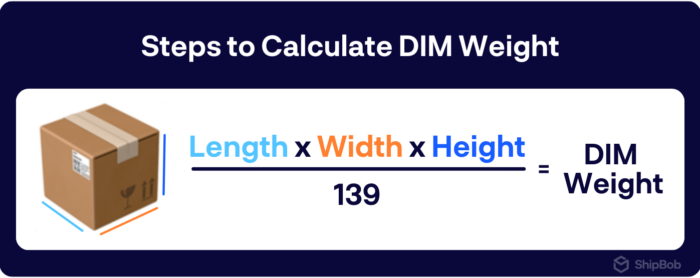
To get the DIM weight, you would multiply 24” × 12” × 12”, then divide by 139 to get 25.
In this scenario, the courier will use your DIM weight, since it’s greater than your deadweight. Even though your package only weighs 3 pounds, it would be billed as if it weighed 25 pounds.
You can see that inefficient packaging quickly multiplies your costs. You want to keep your product safe, but you also want to steer clear of overly large packages. The smaller, the better!
Storage and warehousing fees
Different warehouses will charge different storage fees. Some charge extra for heavy items or multiple SKUs (stock keeping units, pronounced “skews”). And some impose hidden fees like inbound fees.
Returns and replacements
Fulfillment centers typically charge for returns and replacements. Return charges may actually be higher than the original shipping charge, since the warehouse needs to receive the product and inspect for defects.
Factors to consider when choosing a Kickstarter fulfillment service
When choosing a fulfillment service, there’s no objective best option. You need to find the company that best matches your needs. Consider both the location of your backers and the location of your factory.
Where are most of your backers located? It may make most sense to choose a fulfillment center close to your predominant market to cut down on shipping costs.
On the other hand, a fulfillment center close to your factory may save you warehousing costs. For example, if your factory is in China, look for fulfillment centers in Hong Kong. Hong Kong is a huge warehousing hub, and because it’s a free port, you avoid paying import fees.
Selecting the right fulfillment partner
Reward fulfillment is critical. Don’t entrust this responsibility to just any company. Think of your fulfillment center as more than just a service — it’s a crowdfunding partner. The right partner will streamline your process, enhance the customer experience, and set you up for long-term success.
Evaluate different fulfillment centers based on:
- Experience and expertise
- Technology and integration capabilities
- Pricing structure and transparency
Evaluating fulfillment centers
Start gathering a list of potential fulfillment partners in your desired location. Read reviews and testimonials. What experiences have other creators and business owners had with this company?
Also consider scalability. Can it handle fluctuations in order volume, especially during peak shipping season? If your campaign is wildly successful, can it handle unanticipated growth? As you expand, can it become a long-term fulfillment partner for your e-commerce business?
Assessing experience and expertise
Your fulfillment center should have experience not just in crowdfunding but also in your specific product type. Is your product heavy and bulky? Is it fragile and delicate? Is it climate-sensitive? Perishable? Different products require different storage methods, temperature controls, and specialty labor.
Be especially careful if your product has batteries. Certain batteries, such as lithium ion, stand-alone power packs, and disconnected batteries, are considered “dangerous goods” and can impose an additional cost with couriers. An experienced company can help you obtain any necessary certifications or paperwork. The last thing you want is to be waylaid at customs and hit with unexpected fines.
Technology and integration capabilities
Compare each fulfillment center’s integration capabilities. How well does it integrate with your crowdfunding platform? Also think about the long-term vision. If your goal is e-commerce, does your fulfillment center integrate with platforms like Shopify, eBay, or Amazon?
Pricing structure and transparency
When gathering quotes, get a clear understanding of each company’s pricing structure. Look for set-up fees, storage fees, pick and pack fees, shipping fees, and return fees.
Some quotes are more transparent than others. Be wary of any hidden fees, like inbound fees, account management fees, or penalties. Don’t assume that if you don’t see a fee, that it won’t apply. If you’re unsure, ask. It’s always better to over-clarify than to get a nasty surprise later on.
Case studies: Successful crowdfunding fulfillment
Our client Arthur Caldona raised $1.3M on Kickstarter for his campaign, Author Clock. This is an incredible feat — only 0.138% of crowdfunding campaigns make it to seven figures.
But now he faced a dilemma. He had over 8,000 orders to process, package, and ship. And if things went off the rails, these 8,000 customers could leave negative reviews and sink his brand image.
Arthur needed the support of a reliable fulfillment center.
Arthur used EasyShip to send back surveys post-campaign. Backers received an automated email where they could confirm or change their shipping address.
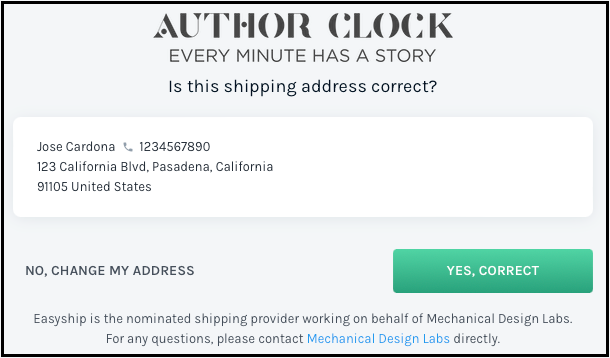
Backers could choose from three shipping options and add on shipping insurance.
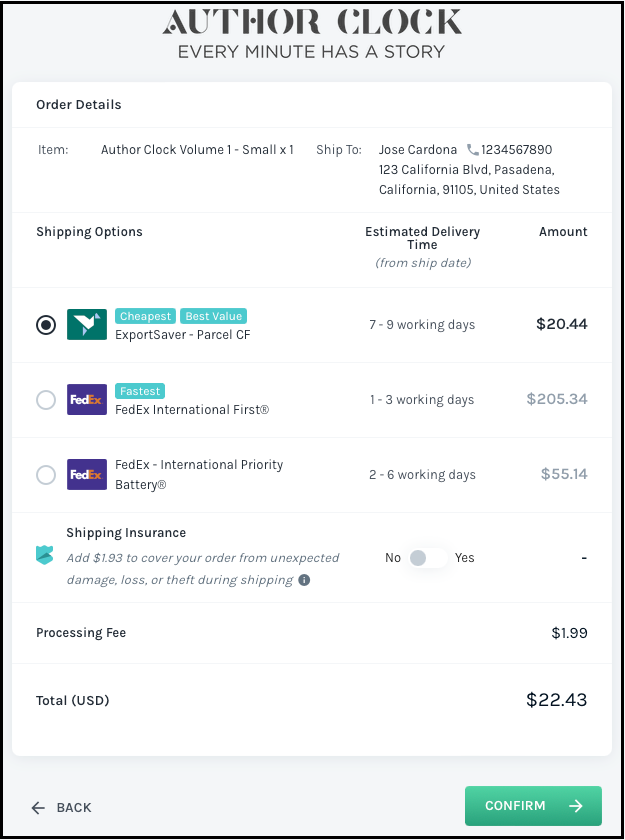
Once a backer submitted their survey, their order was processed and shipped within a week. The backer received a tracking number as soon as their package reached the courier.
Arthur also worked tirelessly to decrease shipping costs for his customers. When he secured a substantial cost decrease for his international customers, he offered a refund for backers who’d already paid the higher fees. A few months later, he secured more affordable rates for his US customers too.
Every step of the way, he updated his backers. He released shipping schedules. Reported back on his factory visits. Celebrated key shipping milestones. And when delays happened, he gave his backers the heads up, sincerely apologized, and even offered discount codes.
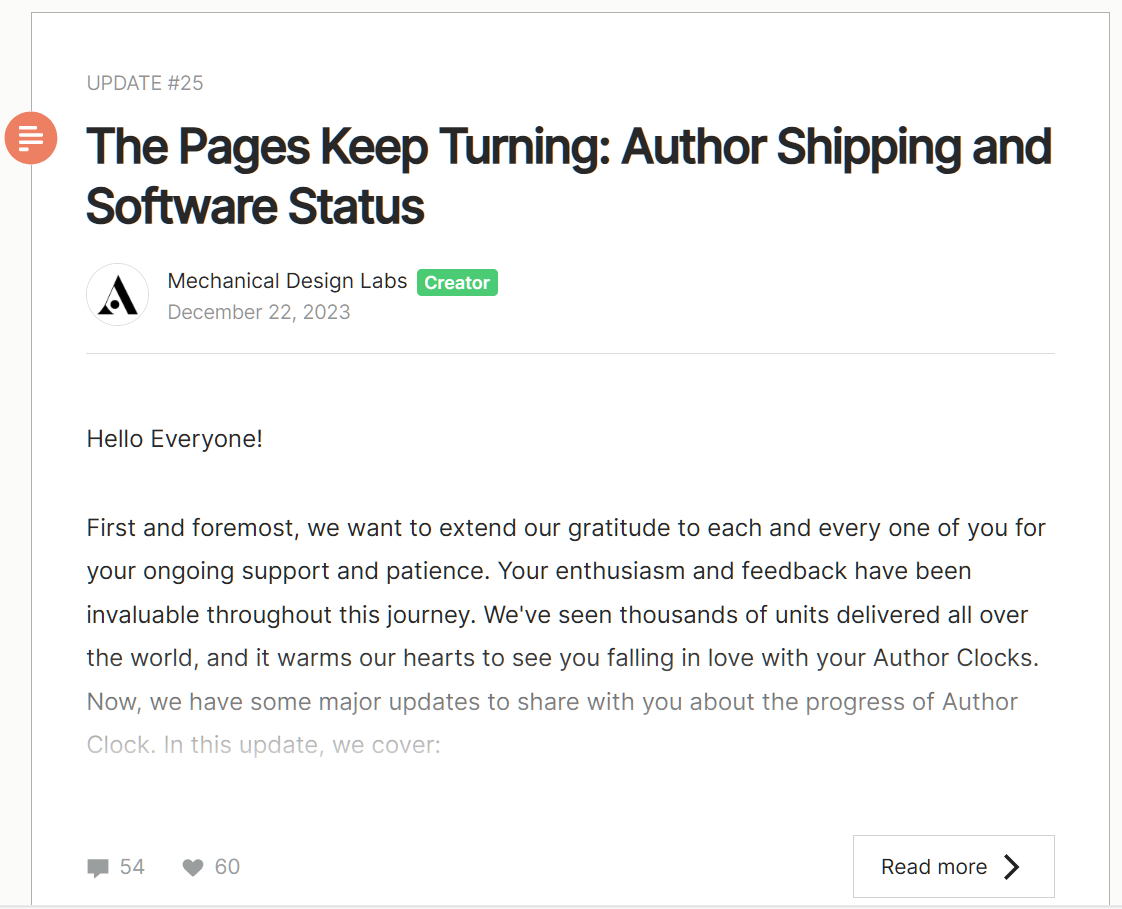
Thousands of customers all over the world are now enjoying their Author Clocks. Arthur’s story tells us that reward fulfillment is paramount. Your campaign gets customers to come, but your fulfillment strategy determines whether they stay.
Best practices for crowdfunding fulfillment
So how do you ensure timely rewards delivery in your crowdfunding campaign? Implement these best practices:
- Regularly update backers on progress
- Provide detailed and accurate shipping information
- Maintain transparency and address concerns promptly
- Seek feedback and learn from each campaign
Regularly update backers on progress
Give your backers frequent updates on your campaign, production, and shipping. Make them part of the journey. The more they feel included, the more patient and understanding they will be if any hiccups happen down the road.
Provide detailed and accurate shipping information
During the campaign, make sure you communicate whether your reward pricing includes shipping and whether international backers will need to pay additional fees.
If you are charging for shipping after the campaign, make sure you clarify that upfront. Otherwise, you’ll have a lot of angry and confused customers.
Our campaign SplatterDōm set clear expectations for backers. First, we included shipping information in the reward message.
We left a more detailed message in the “shipping” section of the campaign page.
The detailed breakdown meant backers could accurately factor in shipping costs when deciding how much to spend on your campaign. The transparency built trust and prevented cancellations. We raised $85,940 CAD on Kickstarter.
Maintain transparency and address concerns promptly
We can’t stress enough that communication is key. Stay on top of comments, reviews, and messages. Address questions and concerns as soon as they arise.
Keep your backers in the loop about any shipping delays. It’s better to be transparent about the bad and the ugly than to withhold important information. Open and honest communication goes a long way towards building customer loyalty.
Seek feedback and learn from each campaign
Even with all the forethought in the world, you won’t get it perfectly right on your first try. And that’s okay! Keep asking backers for feedback. Locate areas of improvement. When, where, and why did delays happen? Where did you spend more or less money than expected? What were the most common customer issues?
Every piece of information helps you mature and expand your brand. For your next product and next campaign, you’ll be even better prepared for success.
Final thoughts
By now, we know that crowdfunding fulfillment shouldn’t be an afterthought.
Too often, we see amazing campaigns crumble to dust when product creators can’t manage crowdfunding deliverables. On the other hand, a successful fulfillment strategy wins you incredibly loyal customers and puts you on the radar for larger investors and retailers.
Today, we learned how crowdfunding fulfillment contributes to the long-term success of your brand:
- The process of crowdfunding fulfillment
- The importance of timely rewards delivery in crowdfunding
- How to evaluate crowdfunding fulfillment services
- Best practices for crowdfunding fulfillment
Today, we learned how crowdfunding fulfillment contributes to the long-term success of your brand:
- The process of crowdfunding fulfillment
- The importance of timely rewards delivery in crowdfunding
- How to evaluate crowdfunding fulfillment services
- Best practices for crowdfunding fulfillment
Too often, we see amazing campaigns crumble to dust when product creators can’t manage crowdfunding deliverables. On the other hand, a successful fulfillment strategy wins you incredibly loyal customers and puts you on the radar for larger investors and retailers.
Don’t let crowdfunding fulfillment be an afterthought.




